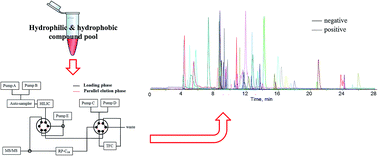New instrumentation for large-scale quantitative analysis of components spanning a wide polarity range by column-switching hydrophilic interaction chromatography-turbulent flow chromatography-reversed phase liquid chromatography-tandem mass spectrometry†
Abstract
The achievement of satisfactory chromatographic performance for every component regardless of the polarity plays a pivotal role in large-scale targeted metabolomics of complicated matrices; however, it is almost impossible to achieve comprehensive retention of all hydrophilic and hydrophobic substances by solely employing either hydrophilic interaction chromatography (HILIC) or reversed-phase liquid chromatography (RPLC). Given the great complementarity between HILIC and RPLC, we attempted herein to find a superior instrumentation scheme for their online hyphenation. New instrumentation, namely column-switching HILIC-turbulent flow chromatography-RPLC-tandem mass spectrometry (HILIC-TFC-RPLC-MS/MS) was firstly constructed by employing five solvent pumps, two electronic 6-port/2-channel valves, three columns including an Amide-type HILIC column, an HSS T3-type RP column along with a TFC column, a hybrid triple quadrupole-linear ion trap mass spectrometer (Qtrap-MS), as well as some other essential units. Each analytical run was automatically fragmented into loading (0–4 min) and parallel elution (4–32 min) phases via switching both valves. The TFC column was in charge of trapping apolar compounds from the diluted effluent of the Amide column within the loading phase and subsequently transmitting them into the HSS T3 column according to back-flushing in the parallel elution phase. Chromatographic separations of hydrophobic substances were accomplished on the HSS T3 column, whereas the Amide column took the load of separating the other substances. Qtrap-MS always received both eluents from the HILIC and RP columns. Three existing hyphenated HILIC-RPLC schemes, such as serially coupled RPLC-HILIC, guard column-(HILIC/RPLC), and HILIC-trapping column-RPLC, were involved for comparisons. With the assignment of an optimized elution program for each scheme, HILIC-TFC-RPLC-MS/MS was slightly better than the other ones for large-scale monitoring of polar and apolar components in a mimic compound pool containing 100 components. Above all, the integrated HILIC-TFC-RPLC-MS/MS platform can serve as a feasible choice to gain a holistic view regarding both hydrophilic and hydrophobic components in complicated matrices.



 Please wait while we load your content...
Please wait while we load your content...